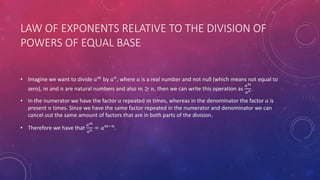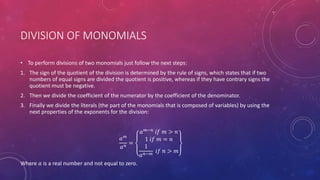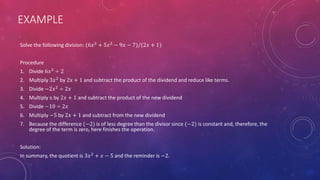Division of polynomials
- 1. ALGEBRAIC DIVISION BY: M├ōNICA ELIZONDO YANN VILLARREAL
- 2. OBJECTIVES ŌĆó By the end of this lesson you should be able to: ŌĆó Perfom divisions of polynomials
- 3. LETŌĆÖS GET STARTED! ŌĆó To perform the operation of division you have to apply certain laws of the exponents that we havenŌĆÖt seen yet, but donŌĆÖt worry! because we are going to proceed to explain them in the following slides.
- 4. LAW OF EXPONENTS RELATIVE TO THE DIVISION OF POWERS OF EQUAL BASE ŌĆó Imagine we want to divide ØæÄ ØæÜ by ØæÄ Øæø , where ØæÄ is a real number and not null (which means not equal to zero), ØæÜ and Øæø are natural numbers and also ØæÜ Ōēź Øæø, then we can write this operation as ØæÄ ØæÜ ØæÄ Øæø . ŌĆó In the numerator we have the factor ØæÄ repeated ØæÜ times, whereas in the denominator the factor ØæÄ is present Øæø times. Since we have the same factor repeated in the numerator and denominator we can cancel out the same amount of factors that are in both parts of the division. ŌĆó Therefore we have that ØæÄ ØæÜ ØæÄ Øæø = ØæÄ ØæÜŌłÆØæø .
- 5. ZERO EXPONENT ŌĆó Now that we are considering exponents you might ask what is the meaning of powering a factor to the zero exponent? In order to explain this letŌĆÖs use the previous rule of powers of the division. ŌĆó Be ØæÄ a real and not null number and Øæø a natural number different from zero. Let us obtain ØæÄ Øæø ØæÄ Øæø by two different ways. The first is by applying the rule of division of powers, in this case we have that ØæÄ Øæø ØæÄ Øæø = ØæÄ0 . Also we know that ØæÄ Øæø ØæÄ Øæø = 1, because both factors cancel each other. So we conclude that for all ØæÄ ŌēĀ 0, ØæÄ0 = ØæÄ ØæøŌłÆØæø = ØæÄ Øæø ØæÄ Øæø = 1, this is ØæÄ0 = 1.
- 6. ALGEBRAIC DIVISION ŌĆó Do you remember from the previous topic that there are different types of algebraic multiplications? Well the same applies for algebraic division. There are three different types of operation that can be done algebraically and they are: 1. Division of monomials 2. Division of a polynomial by a monomial 3. Division of two polynomials
- 7. DIVISION OF MONOMIALS ŌĆó To perform divisions of two monomials just follow the next steps: 1. The sign of the quotient of the division is determined by the rule of signs, which states that if two numbers of equal signs are divided the quotient is positive, whereas if they have contrary signs the quotient must be negative. 2. Then we divide the coefficient of the numerator by the coefficient of the denominator. 3. Finally we divide the literals (the part of the monomials that is composed of variables) by using the next properties of the exponents for the division: ØæÄ ØæÜ ØæÄ Øæø = ØæÄ ØæÜŌłÆØæø Øæ¢Øæō ØæÜ > Øæø 1 Øæ¢Øæō ØæÜ = Øæø 1 ØæÄ ØæøŌłÆØæÜ Øæ¢Øæō Øæø > ØæÜ Where ØæÄ is a real number and not equal to zero.
- 8. PROBLEMS ŌĆó Solve the following divisions of monomials: a) 8ØæÄ8 ØæÅ12 2ØæÄ5 ØæÅ7 b) 24ØæÄ3 ØæÅ12 ØæÉ9 ŌłÆ6ØæÄØæÅ8 ØæÉ9 c) 30Øæź4 Øæ”2 ØæÉ ŌłÆ5ØæźØæ”ØæÉ
- 9. ANSWERS a) 8ØæÄ8 ØæÅ12 2ØæÄ5 ØæÅ7 = 4ØæÄ3 ØæÅ5 b) 24ØæÄ3 ØæÅ12 ØæÉ9 ŌłÆ6ØæÄØæÅ8 ØæÉ9 = ŌłÆ4ØæÄ2 ØæÅ4 c) 30Øæź4 Øæ”2 ØæÉ ŌłÆ5ØæźØæ”ØæÉ = ŌłÆ6Øæź3 Øæ”
- 10. DIVISION OF POLYNOMIAL BY A MONOMIAL ŌĆó To perform divisions of a polynomial you just have to divide each of the terms of the polynomial by the monomial. LetŌĆÖs see an example: ŌĆó Perform the division of 16Øæź5ŌłÆ12Øæź2+4Øæź 4Øæź ŌĆó Solution: 4Øæź4 ŌłÆ 3Øæź + 1 16Øæź5ŌłÆ12Øæź2+4Øæź 4Øæź = 16Øæź5 4Øæź ŌłÆ 12Øæź2 4Øæź + 4Øæź 4Øæź = 4Øæź4 ŌłÆ 3Øæź + 1
- 11. DIVISION OF TWO POLYNOMIALS ŌĆó In general, to divide two polynomials follow the next steps: 1. The dividend and divisor are ordered according to the decreasing exponents of one variable that appears in both, including terms with coefficient zero for the missing powers. 2. It is divided the first term of the dividend by the first term of the divisor to obtain the first term of the quotient. 3. The first term of the quotient is multiplied by the divisor and it is subtracted the product of the dividend, the difference that is obtained is the new dividend. 4. To find the second term and all the consecutives of the quotient, the previous steps are repeated until the degree of the polynomial obtained is lees than the degree of the divisor. 5. The results is then verified with the formula: Øæ×ØæóØæ£ØæĪØæ¢ØæÆØæøØæĪ ØææØæ¢ØæŻØæ¢ØæĀØæ£Øæ¤ + Øæ¤ØæÆØæÜØæÄØæ¢ØæøØææØæÆØæ¤ = ØææØæ¢ØæŻØæ¢ØææØæÆØæøØææ We recommend you to prove the result of all your divisions, jut to make sure that you followed all steps correctly.
- 12. EXAMPLE Solve the following division: (6Øæź3 + 5Øæź2 ŌłÆ 9Øæź ŌłÆ 7)/(2Øæź + 1) Procedure 1. Divide 6Øæź3 ├Ę 2 2. Multiply 3Øæź2 by 2x + 1 and subtract the product of the dividend and reduce like terms. 3. Divide ŌłÆ2Øæź2 ├Ę 2Øæź 4. Multiply x by 2Øæź + 1 and subtract the product of the new dividend 5. Divide ŌłÆ10 ├Ę 2Øæź 6. Multiply ŌłÆ5 by 2Øæź + 1 and subtract from the new dividend 7. Because the difference (ŌłÆ2) is of less degree than the divisor since (ŌłÆ2) is constant and, therefore, the degree of the term is zero, here finishes the operation. Solution: In summary, the quotient is 3Øæź2 + Øæź ŌłÆ 5 and the reminder is ŌłÆ2.












